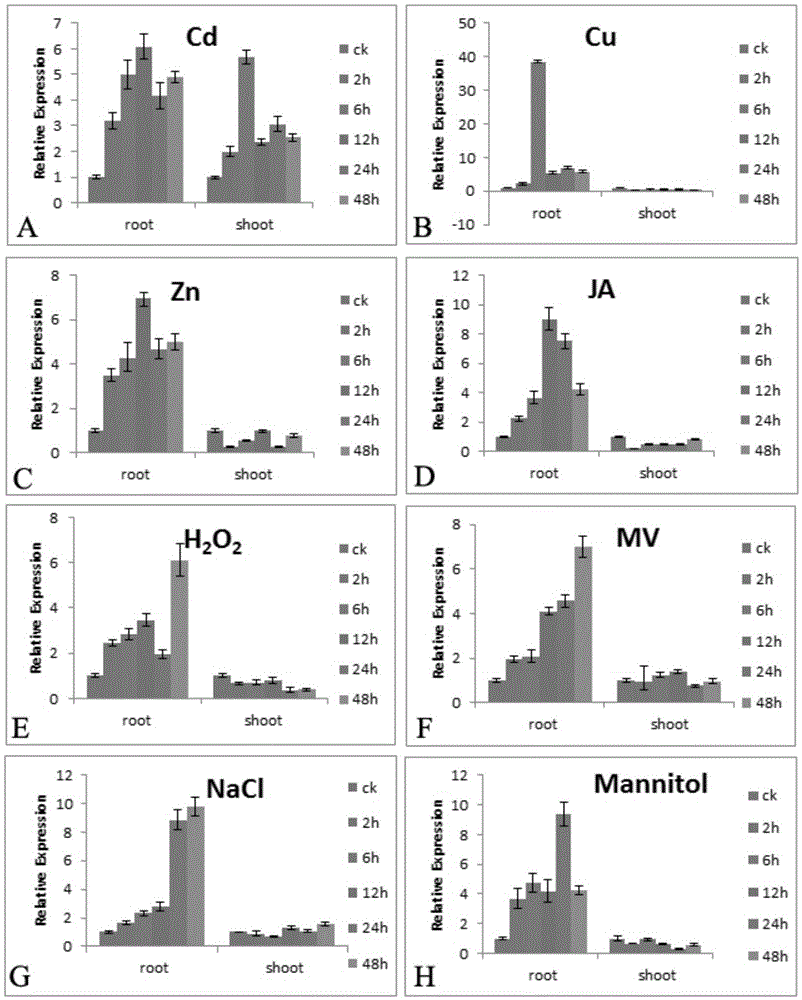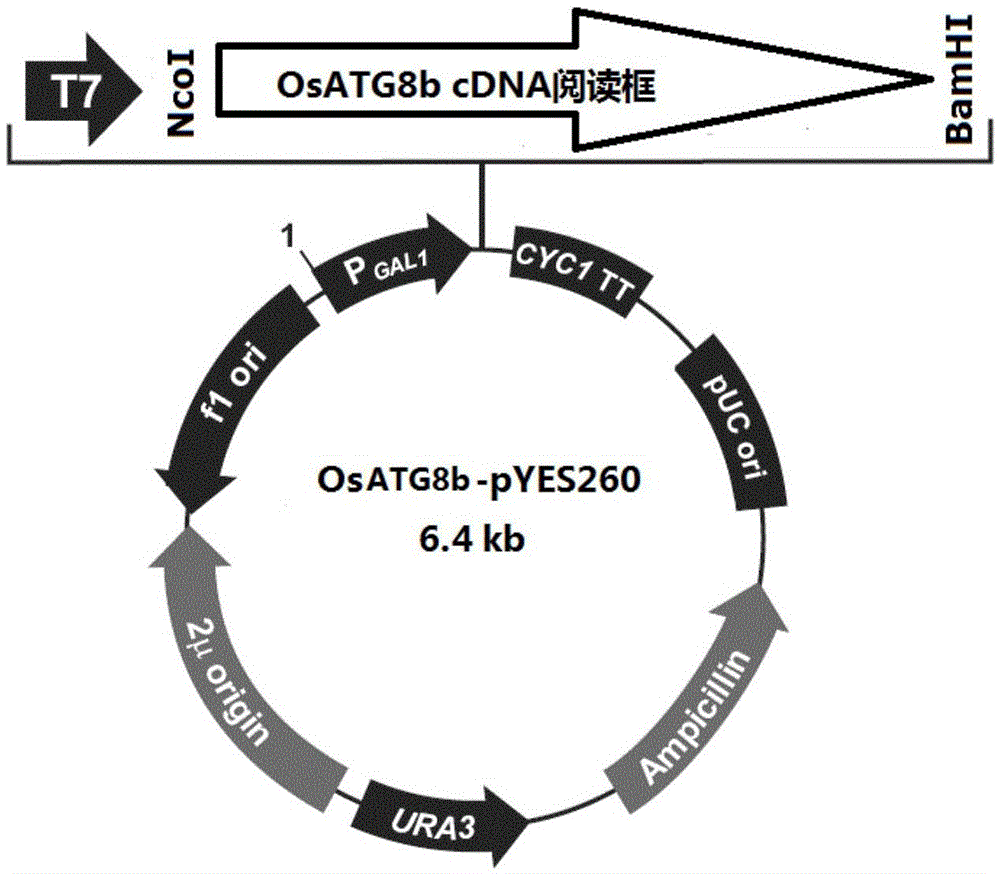Oryza sativa autophagy-related protein OsATG8b (oryza sativa autophagy-related gene 8b) and novel application of gene of oryza sativa autophagy-related protein OsATG8b
An autophagy-related protein and rice technology, applied in the fields of application, genetic engineering, virus/bacteriophage, etc., can solve problems affecting heavy metal tolerance or accumulation
- Summary
- Abstract
- Description
- Claims
- Application Information
AI Technical Summary
Problems solved by technology
Method used
Image
Examples
Embodiment 1
[0039] Example 1: The expression of OsATG8b gene is regulated by the induction of heavy metal cadmium, zinc, copper and other stress factors and hormones
[0040] The rice variety used in the present invention is Nipponbare (Oryzasativa L.japonica.cv.Nipponbare), and the seeds are preserved and provided by the South China Botanical Garden of the Chinese Academy of Sciences. The rice seeds were germinated with 1 / 2 liquid MS medium, and after soaking to accelerate germination, the rice seedlings were transferred to a 23°C culture room (16h light / 8h dark), and continued to be cultured with 1 / 2MS liquid medium for 2 weeks. Then use CdCl containing 2 (50μM), ZnSO 4 (2mM), CuCl 2 (150μM), NaCl (200mM), mannitol (300mM), H 2 o 2 (5mM) and JA (92μM) 1 / 2MS liquid medium to treat rice seedlings, collect 0.5g each of rice young leaves and radicles after stress treatment 0h, 2h, 6h, 12h, 24h and 48h, for extracting total RNA . The extraction of RNA was carried out according to the s...
Embodiment 2
[0045] Example 2: Cloning of OsATG8b gene and construction of yeast recombinant expression vector OsATG8b-pYES260
[0046] The seedling leaves of the japonica rice variety Nipponbare (preserved in the South China Botanical Garden) were taken, and the RNA of the young leaves was extracted and reverse-transcribed into cDNA. Using the cDNA as a template, primers OsATG8bYEF: 5'-TTTCAGGGCGCCATGGCCAAGAGCTCGTTCAA-3' and OsATG8bYER: 5'-CGTTACTAGTGGATCCTAGAGCAGCCCAAAGGTG- 3' (SEQIDNO.7 and SEQIDNO.8), the full-length cDNA reading frame of the OsATG8b gene was amplified by high-fidelity Taq enzyme PCR. For the PCR system used, refer to the instruction manual of PrimeSTARHSDNAPolymerasewithGCBuffer from TaKaRa Company. The amplified DNA fragment was in accordance with the instructions of HiPureGelPureDNAKits of Magen Company. The recovered fragment was used for insertion into the yeast expression vector pYES60. Saccharomyces cerevisiae expression vector pYES260 was digested with NcoI a...
Embodiment 3
[0047] Example 3: Expression of OsATG8b gene in Saccharomyces cerevisiae improves tolerance of yeast to heavy metal cadmium
[0048] Cultivate Saccharomyces cerevisiae strain Δycf1 (purchased from Euroscarf, European Yeast Research Center, http: / / web.uni-frankfurt.de / fb15 / mikro / euroscarf / , strain number Y04069), use pYES260 plasmid and recombinant OsATG8b-pYES260 to the above yeast to convert. Since the OsATG8b gene is placed under the regulation of the yeast galactose-induced promoter PGAL1 (see figure 1 shown), OsATG8b-pYES260 was transformed into Saccharomyces cerevisiae and grown on the growth selection synthetic medium (Selective Growth Synthetic Medium, SDmedium) supplemented with galactose to induce heterologous overexpression of OsATG8b in yeast.
[0049] The method used for yeast transformation is the lithium acetate conversion method, and the specific steps are as follows:
[0050] 1) Inoculate a single colony of the yeast strain Δycf1 to be transformed into 5 mL o...
PUM
 Login to View More
Login to View More Abstract
Description
Claims
Application Information
 Login to View More
Login to View More - R&D
- Intellectual Property
- Life Sciences
- Materials
- Tech Scout
- Unparalleled Data Quality
- Higher Quality Content
- 60% Fewer Hallucinations
Browse by: Latest US Patents, China's latest patents, Technical Efficacy Thesaurus, Application Domain, Technology Topic, Popular Technical Reports.
© 2025 PatSnap. All rights reserved.Legal|Privacy policy|Modern Slavery Act Transparency Statement|Sitemap|About US| Contact US: help@patsnap.com



